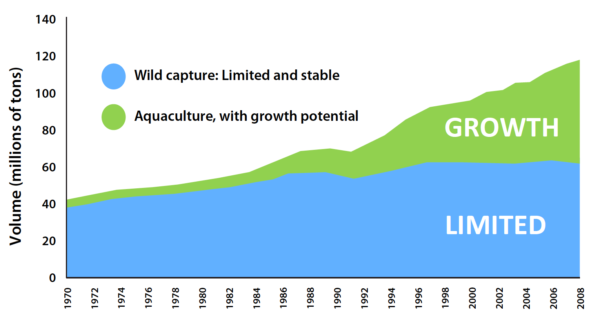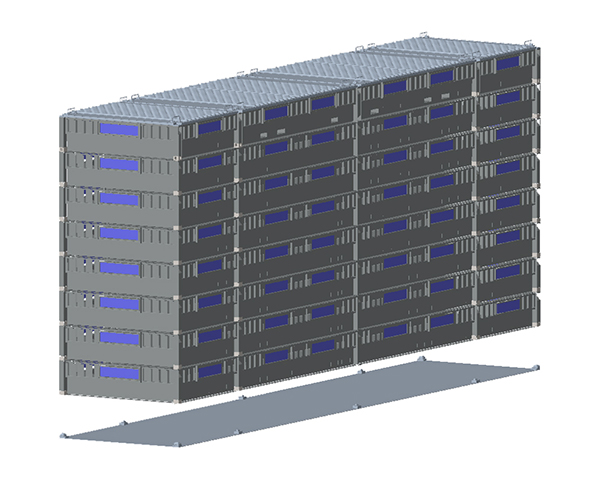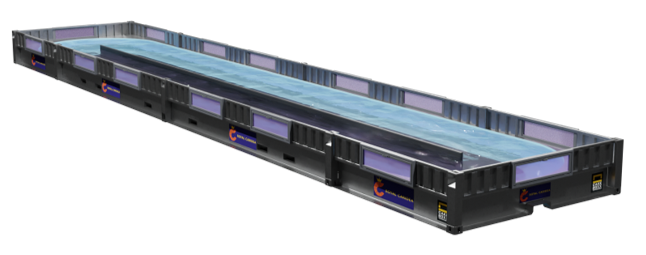Royal Caridea is a company poised to transform the shrimp production industry while addressing unmet market needs and creating significant economic opportunity for investors.

Transformation may be a bold statement or one you hear from many others but, in this case, the solution to our industry’s production issues requires a step change in thinking and Royal Caridea has designed that step change.
Like other types of seafood, the answer to the shrimp industry’s problems lies in aquaculture. However; new methodologies must be implemented. This is Royal Caridea’s focus.
Broadly speaking aquaculture is aquafarming. The cultivated organism may be fish, crustaceans, mollusks, aquatic plants, algae, and other organisms. Aquaculture involves cultivating freshwater and/or saltwater populations under controlled conditions. Farming, itself implies some form of intervention in the rearing process to enhance production, such as regular stocking, feeding, protection from predators, etc.
The quantity of wild-capture seafood brought to market began to level off several decades ago. Aquaculture became the only alternative. Today global per capita farmed seafood consumption has surpassed human consumption of wild-caught seafood.
Many countries jumped into shrimp production to meet demand and built massive aquaculture facilities to produce farm shrimp.
Yet, disease, land destruction, pollution, weather, a batch process, no trace back has become increasingly problematic. Of these issues, disease is the #1 threat to production and the batch-nature of production makes availability “unpredictable”.
Industry Response – Incremental at best
Notably, an industrial leader, José Antonio Camposano (Executive President National Chamber of Aquaculture from Ecuador) Speaking March 12, 2018 At Seafood Expo North America, stated the following:
“Up until this point the shrimp sector has been a commodity market, and quality has often taken a back seat to prices, but there are consumers who want more choice. Consumers who care about what they eat, and how it has been produced, and it is time they were offered a choice of farmed shrimp that meets the highest standards and is fully traceable to its origins. Shrimp grown by producers who care, for consumers who care.”
And Zuridah Merican (Editor of Aqua Culture Asia Pacific Chairperson of The Aquaculture Roundtable Series 2018), points out “Today the industry is being sustained by high prices, which is not expected to continue. Living with diseases, inconsistent harvest volumes and crop losses may be the new normal, but what the industry needs now is a revolutionary change. This requires a much-needed shift in production paradigms if Asia is to reach the global production levels prior to the EMS [early mortality syndrome] crisis.”
Change must happen! Royal Caridea believes a step-change approach in technology is required to replace the current paradigms and address these issues.
We decided to look elsewhere for ideas on how to transform the existing production models.
Vegetable farming is a great analogy for how shrimp production might be transformed. Traditionally, vegetable farming has been land-intensive, batch-oriented and susceptible to weather and disease. Most crops are seasonal, making availability unpredictable, not unlike pond based shrimp farming.
Change processes leading to a new paradigm:
- Indoor, vertical, climate-controlled – now continuous year-round production
- Modular, segregated production – disease containment, biosecure, scalable
- High-density, limited land – lower cost, more responsible
- Location flexibility, local to market – fresh product to meet market demand
- Environmentally friendly – reduced waste, less pollution
The concept of locally grown high intensity farming close to urban population centers is particularly appealing to American shrimp aquaculture interests.
Going vertical reduces land requirements and allows siting farms closer to markets. Vertical farms also require less water, fertilizer, and pesticides, thus reducing environmental impact and improving food quality. In addition, high-intensity farming indoors allows year round continuous production and better bio-security.
What would the implementation of these concepts by Royal Caridea to shrimp farming mean?
Could shrimp be available in predictable, healthy quantities every day of the year?
Could we reduce land, water, feed waste and use of antibiotics?
Could we create a scalable food source?
And, can we do it profitably?
Royal Caridea’s solution to the issues of the industry was designed to answer “YES” to these questions and more.
Royal Caridea’s Shrimp Farming Transformation

Shrimp production is an industry ripe for transformation. By moving from resource-intensive production far from market to a more local, sustainable, reliable and commercially viable alternative, rising demand and changing market tastes can be satisfied. Royal Caridea has developed its technology to meet these challenges.
The key to enabling transformation begins with Royal Caridea’s production approach. Yes, shipping containers! They are the building blocks of our technology and the epicenter of the modular step change we will bring to the industry.
We’ve named our solution GEN 2
Together with researchers at Texas A&M University, GEN 1 was developed a few years ago. Using GEN 1, it was shown that shrimp could predictably and repeatedly be raised without health issues, had great taste and were economical to produce.
GEN 2 Shrimp Farming is an extension of the GEN 1, i.e., Super Intensive Shrimp Farming Technology (SIRSFT). GEN 2, is a method for shrimp aquaculture, in which, all growth phases and essential operations are modularized and integrated to form a multi-phasic synchronous super-intensive shrimp production system controlled by a custom-designed cyber-physical platform.
GEN 2, is a patent-pending step-change in shrimp production that is ready for commercialization. The system will allow us to raise 16 and 26-gram shrimp in <4 months. Production plants operate in a continuous manufacturing mode, producing over thirty-five hundred pounds of shrimp each day or 1.3 million pounds per year.
GEN 2 is designed to alleviate factors that have been impediments to land-based shrimp aquaculture. Example, water, land, energy, climate, etc.
- Shrimp are stocked and raised In significantly lower average water depths, i.e., as low as 25 cm. Reduced water volumes also mean reduced operational cost and reduction in scale of the Recycling Aquaculture System (RAS).
- Operating costs can be reduced because of isolation and containment. Shrimp are housed in insulated units that are non-contiguous with the ambient environment; resulting in minimal water loss, minimal thermal exchange, etc. Operationally, GEN 2 is designed to establish a near-perfect growing environment. Moreover, even the building temperature is rendered moot, meaning operations can be situated anywhere.
- Very significantly, the technology facilitates higher production per m2 of water footprint, i.e., >100 kg shrimp/m2 of water footprint/yr. can be reliably produced Stated another way, using GEN 2, production capacity is >1,000,000 kg/ha water footprint/yr. The production capacity is a reflection of the multi-phasic aspect of the technology, i.e., high numbers of shrimp are stocked but operationally through-out the grow-out cycle the biomass is maintained at <4 kg/m2. Effectively thirteen cycles can be run through the system per year.
So, how do we do it?
GEN 2 components are comprised of modular sub-components, that are compartmentalized by function for fabrication and application. Design is important because everything must operate seamlessly when sub-assemblies are integrated.
Desiring to meet the pressure of driving higher rates of production per unit area along with minimizing costs, all sub-components are designed to be modularized for rapid onsite assembly.
In addition, all sub-components are fabricated in standardized Hi-Cube 53 ft intermodal containers. These structures are made of steel and are structurally rigid allowing for vertical stacking.
Each container contains three raceways, or troughs. The water quality and physical conditions are monitored and controlled by computerized feedback loops, thereby, maintaining an ideal isolated environment for optimal shrimp development.
The raceways or production sub-units are designed to have several features to accommodate shrimp production.
- Designed to fit in inter-modal container
- Designed to operate completely independently from each other while being connected to a RAS and feeding system.
- Each production-sub-unit has built in sensors that feedback to a computer.
- Each production sub-unit is designed with aeration connections and is designed to accommodate up to 15 inches of water.
- Each production sub-unit is designed with pit and connections to accommodate removal of detritus and harvesting of shrimp.
- Pre-larval stage shrimp are introduced into the system in one raceway and grown for one month. At that point they enter the grow-out stage.
- As the shrimp grow, the colony is periodically subdivided into other raceways so that the biomass of the shrimp in any one raceway remains consistent. Biomass control is key to Royal Caridea multi-phasic approach.
- Each shrimp colony is subdivided three times at monthly intervals. It takes four months to raise 26-gram shrimp from the pre-larval stage to that ready for Market!

This modular approach not only creates an optimal growing environment and isolates any disease element, it simplifies plant construction. Raceway-equipped containers can be constructed at a central site and shipped to the planned location. With this approach, the build-out of a single, large scale plant can be accomplished in just a few months.
To illustrate how compact a GEN 2 plant can be, a design concept for a plant capable of producing 20,000 lb./yr. is presented. The only difference between this plant and a 1.0 MM pound plant/yr. is space and the number of production units.
One pair of containers, shown here in orange, will be dedicated as a nursery where post-larvae are nurtured before transfer to the grow-out units.
In red are the production units. The big difference between this size production plant and a larger one is the number of production units. Each unit is a pair of stacked containers holding three raceways each.
At the top of the diagram, in the green box, you’ll see the water and waste handling systems – a key to maintaining the optimal growing environment.
Aside from production equipment and operation, packaging and shipping facilities, as well as office, lab and locker room space, are necessary and these are illustrated.
